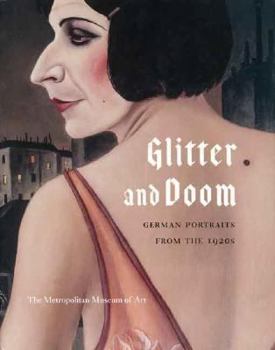Glitter and Doom: German Portraits from the 1920s
In the 1920s Germany was in the grip of social and political turmoil: its citizens were disillusioned by defeat in World War I, the failure of revolution, the disintegration of their social system,... This description may be from another edition of this product.
Format:Hardcover
Language:English
ISBN:0300117884
ISBN13:9780300117882
Release Date:December 2006
Publisher:Metropolitan Museum of Art New York
Length:292 Pages
Weight:3.40 lbs.
Dimensions:1.0" x 9.0" x 11.3"
Related Subjects
Art Arts, Music & Photography History & Criticism Human Figure Painting Portraits ThemesCustomer Reviews
5 ratings
A beautiful exhibition
Published by Thriftbooks.com User , 17 years ago
This is the catalogue for a beautiful exhibition held at the Met last year. The paintings reproduced here are among the best examples of the New Objectivity, a movement that was able to depict the atmosphere, the soul, the world of the Weimar Republic, that brief time span when pre-war Germany enjoyed freedom in the arts and in the minds. These gripping paintings show how ultimately doomed that world was and how the artists were the first to sense the tragic developments that were to succeed it. The front cover, a detail of one of Christian Schad's best known paintings, is a perfect illustration of a society that seems to have enjoyed life knowing that death would come too soon, with the end of that joyful and poetic decadence that was the Berlin of the 1920's.
Glitter and Doom
Published by Thriftbooks.com User , 17 years ago
Twice viewed the exhibition at the Metropolitan Museum here in New York. German art in the 20s is raw, obscene and decadent. A raucus reflection on hard times there. They had just suffered WW1, in the midst of fascism, insane inflation, etc. Highlight: Otto Dix is a wild artist, forever a favorite now. Also a DaDa artist. I am a frequent art museum visitor. Therefore, in my opinion, this catalogue did the show great justice which is not aways the case.
Beautiful catalog for
Published by Thriftbooks.com User , 17 years ago
The BEST museum show I have seen in a long time. Sabine Rewald is a truly great curator, the book is smart and well designed, great color reproductions.
More DOOM than glitter
Published by Thriftbooks.com User , 18 years ago
This is an amazing art book about the German underworld in the 1920s before the reign of Hitler during the fall of the Weimar Republic after World War I. This book contains mainly dark and disturbing art pieces that are featured at the Metropolitan Museum of Art through February 2007. Very interesting to read about and it basically sums up the entire collection and more that are featured at the MET. Great book... not for the squimish. This book is really very dark and it does tell the true story of Germany during the 20s.
A Lively Look at the Decadence of the Weimar Republic Years
Published by Thriftbooks.com User , 18 years ago
Author Sabine Rewald has written a fascinating survey that integrates the German psyche of the period between the gloom of World War I with its decimation of hope for a revolution and the rise of Hitler who ended any fantasies about the dreams of glitter that infused the artists and wealthy people of Germany. In this beautifully designed and lushly illustrated book are the works of the major artists of the time, the ones we immediately recognize such as Otto Dix, Georg Grosz and Max Beckmann, as well as names less familiar to the general reading audience. These artists captured the decadence and 'cabaret' atmosphere that permeated the denying culture, using as models not only fellow artists and actors but also the spectrum from prostitutes and crime bosses to doctors and lawyers, none being shown in a very flattering light. The many illustrations in the book are true to the original color and seem to capture the delusional elegance and grime that mixed the time so well. The portraits are veneer-like in that they depicted the doomed generation of people on the brink of destruction. If ever there existed a book that reveals the 'decay' and decadence against which Hitler railed this is it. The author wisely elected to employ essayists Ian Buruma and Matthias Eberle whose contributions to the flavor of the times and the influence of the disintegration of morals and taste make the texts readable and very informative. Yale University Press has once again produced an art volume that focuses on a certain period of time that influenced the development of art in the history of a change - in visual art, in literature (from German writers as well as those who flocked to Berlin such as Christopher Isherwood), in music, and in film. It is a book of great importance and one that encourages repeated readings. Grady Harp, November 06





